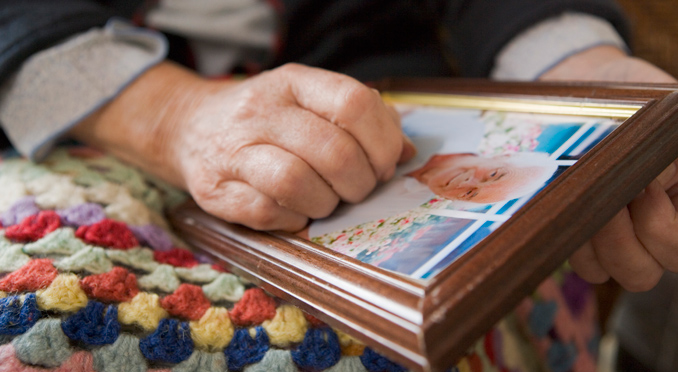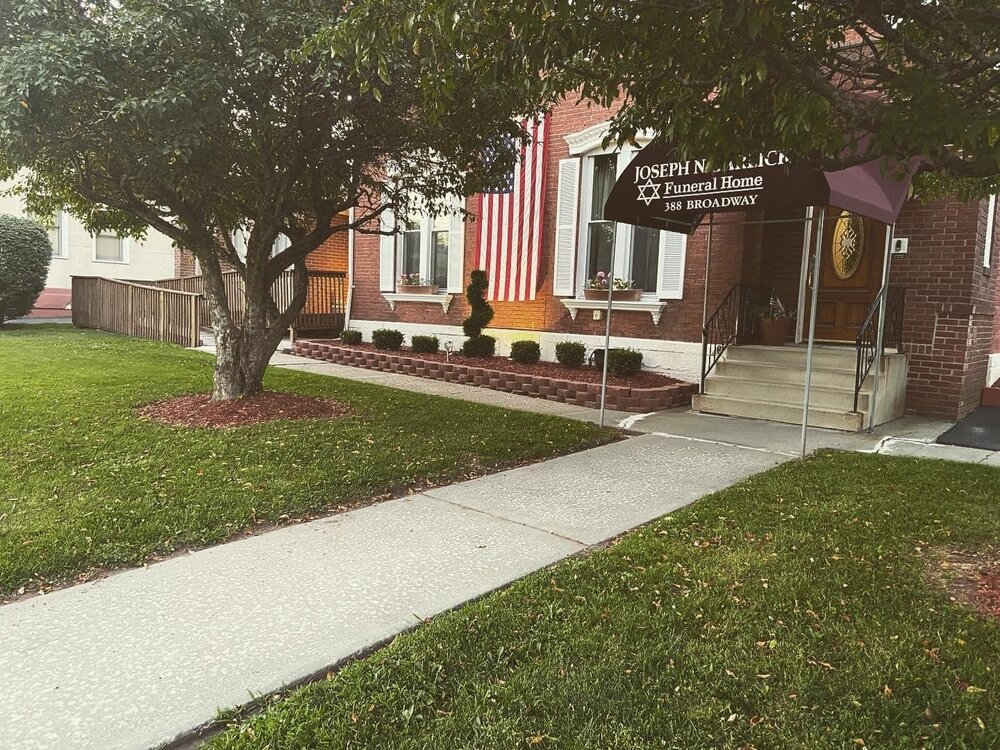This section contains information and definitions of common Jewish traditions and terms.
- Aron – The burial casket. The casket must be made completely of wood, with holes at the bottom. The return of the human remains to the earth should be as swift as possible, in the belief that ultimately it helps to atone for our earthly transgressions, permitting our eternal peaceful rest. Our prophets tell us “From earth you have come, and to earth you shall return.” Wooden caskets disintegrate quickly and therefore are permitted. Metal caskets are not permitted by Jewish law.
- How soon after death should the funeral be held? - The funeral should be held as quickly as possible. The deceased is in much turmoil during the time following expiration, until the burial has occurred. Arrangements should be made immediately upon learning of a death with your funeral home. The closest relatives and the Rabbi should be called to insure that the funeral is held at the earliest possible time. In this way, respect for the deceased is maintained.
- Shmira - The attending to and guarding of the remains from the moment of death until burial. To show respect for the departed, the deceased is never left alone until after burial.
- Shomer- Guard or Watcher who traditionally recites psalms nearby the deceased. In the absence of a family member or friend familiar with the prevailing customs, a shomer can be arranged for by the funeral home.
- Why Shmira?-Because the human being embodies the G-d given soul Neshama it is deserving of the utmost respect. There are two primary reasons for Shmira: 1. To guard the human remain from becoming prey to rodents or insects. 2. Respect for the body which housed the soul during the persons lifetime, is expressed by never leaving the body alone, discarded like a vessel that is no longer of use. While the first reason may not apply in all situations such as where refrigeration and modern sanitary conditions exist, the second reason applies under all circumstances. The presence of a pious Jew reciting Psalms (T’hillim) specifically for the purpose of showing respect for the deceased person is a source of great comfort to the soul.
- Neshama- the G-d given soul. The body hosts the Neshama during the person’s lifetime.
- Tahara - As a newborn is washed and dressed so should the deceased. This is the traditional washing and dressing of the deceased done with the utmost dignity and respect. The tahara is performed by trained members of the Chevra Kadisha (Sacred Society). In accordance with Jewish traditional law, men prepare men, while women prepare women. This process is the essence of the Jewish funeral. Embalming, cosmetizing or any other artificial preparation of the remains is not permitted by Jewish law.
- Why a Tahara? -This beautiful tradition expresses the reverence we feel for the body as the receptacle of the Neshama – the G-d given soul. The body is treated gently and with sensitivity, since it was home to the soul during its sojourn on earth. While tradition insists that the body be as presentable as possible, no attempt is made to cosmetize or to create a life-like appearance through artificial means and devices.
- Who should have a Tahara? - Every Jewish person, regardless of affiliation or level of religious observance should have a Tahara. Like the Bris (circumcision), the Bar and Bas Mitzvah at maturity, Tahara is the universally accepted religious act that completes the Jewish life-cycle. The family should request that a tahara be performed for the deceased.
- Tachrichim - (Takh-ree-kheem) the traditional burial shroud. Traditional white clothing, preferably made of linen, includes: hat, shirt, pants, jacket, belt and wrapping sheet, and for a man, a Tallis, preferably his own, is also worn. These garments symbolize equality and purity.
- Why Tachrichim?
- Simplicity. In the Olam HaEmes, the World of Truth, the deceased is about to enter, one is not defined by material acquisitions, by the quality, cost, or design of clothing, but rather by good deeds and the kind of person one choose to be. The shroud has no pockets, further symbolizing our inability to take along any material possessions on this journey.
- Appropriate Dress. With our belief in Olam Habah, an afterlife, where all men must face the Final Judgment, what more appropriate way to dress than as did the Kohen Godol, the High Priest, for the holiest service of Yom Kippur. In fact, the burial shroud replicates his clothing and therefore linen, which he wore, is the preferred material of the shroud.
- Uniformity. In order not to distinguish between rich and poor, Rabbi Gamliel introduced the shroud as an absolute requirement, thus allowing even the poorest Jews to bury their dead with equal dignity and honor. Whereas traditions in funeral and burial practice may vary somewhat in different parts of the world, the shroud was universally accepted, and Jewish people have been buried in Tachrichim for over two thousand years. - Visiting with and viewing the remains are contrary to Jewish law. According to our tradition, viewing is harmful for both the deceased and the visitor. Furthermore, the face that is seen after death is not the one to remember. Traditionally the face is covered immediately after death.
- K’vurah B'karka – Burial in the ground. Biblical law mandates burial in the ground, filling the grave completely until a mound is formed. Participation in filling the grave is a religious privilege and duty and an expression of honor for the deceased. Cremains are not permitted burial in a Jewish cemetery according to Halacha. Mausoleums and above ground burial are forbidden by Jewish law. The Biblical mandate for burial requires burial in the ground.
- Why not Cremation? - Cremation of the body is seen as one of the most abhorrent transgressions of Jewish tradition and law. Not only does it violate the Biblical mandate for burial, it is seen as the ultimate denial of G-d’s existence. If G-d in fact created man, he certainly retained the right to legislate the disposition of his creation. Cremation has historically been linked to pagan ritual. It also denies the principle of the ultimate Resurrection of the Dead (T’chiyas Hamesim). To reduce the human body to ashes is the harshest form of desecration and indignity conferred upon that which was created in the image of G-d. The Halacha is also clear: Even where the will of the deceased is to be cremated, the will of G-d takes precedence.
- It is seen as expressing that after death, all has ended. Our tradition insists that even though the body has ceased being a fitting receptacle for the soul, the soul still continues to exist on a spiritual plane. According to our tradition, it is meaningful to visit the cemetery periodically, and to pray at the graveside, since the soul is somewhat connected to the place of burial. Furthermore, Judaism does believe in the resurrection of the dead for those who believe and do not deny this important principle of faith.
- K’riah – The practice of rending or cutting a garment, to indicate that one is in mourning. Those observing K’riah are generally adult children, father/mother, brother/sister, or spouse of the deceased. K’riah should be done on a shirt or blouse (preferably) that will be worn for the week of mourning (Shiva period).
- Burial of Limbs- The obligation to bury Jewish remains is absolute. It includes not only a complete body, but limbs also. Unfortunately, this situation arises when a patient undergoes amputation. The family should make sure that the amputated limb is not incinerated by the hospital authorities.
- Washing of Hands: This is done after the funeral, after any visit to the cemetery, or after being in close proximity to a deceased we wash our hands. A container of water should be prepared for this purpose outside the entrance of the residence which one is about to enter. We wash our full hand from the wrist to the finger tips, three times alternately, first the right hand, then the left alternating, right, then left. The hands should be left to air dry, not towel dried.
- Sitting Shiva-Tradition requires that mourners, during the shiva period not sit upon any chair at its normal height. Primarily, the tradition stipulates that the mourners sit on a level lower than that of normal seating height. Whether the seat is comfortable or not is irrelevant. You may put a cushion on a stool or on the floor. Sleeping on a bed of normal height is permitted. The mourner should not rise from his or her seat out of respect for any visitor.
- What are the stages in the Mourning Process?
- Aninus-The period immediately following the passing of a near one, and preceding the funeral and interment. During this time, the family should devote their time and energies exclusively to preparing for the funeral.
- Shiva – The traditional seven-day mourning period, immediately following the burial. We devote the week to mourning of the loss that we have just experienced. We do not distract ourselves from thinking about our loss; rather, we confront our grief directly. Usually during this time, family and members of the community visit.
- Sheloshim – The thirty days following burial (including shiva). After this period, formal mourning is concluded for all relatives other than parents.
- Yud Bais Chodesh - The twelve-month period of formal mourning for parents.
- Yahrzeit - The anniversary of a person’s date of death. - Kaddish – The traditional prayer in praise of God, recited after burial, during the first year, at all three daily services and at the yahrzeit. This prayer should be said by the children at the synagogue, in the presence of the minyan. If the family can not insure that the prayer will be recited during the year, they should arrange for a proxy to recite the Kaddish. The Kaddish is one of the most important and meaningful acts that the family can do to insure that the departed soul is at peace.
Family Checklist
We realize that at this time it may be very difficult to focus. We have put together a checklist of information that you will need to gather, so we can assist you in a timely and professional manner. Some of this information will be asked of you when you make the first call to the funeral home so our staff can assist you properly from the start. Even our service will ask you some basic questions as well.
Basic Questions asked of you:
- Name of Deceased
- Where the deceased is located (Hospital, Hospice, Home, or Nursing facility)
- Phone number or address where the deceased is located.
- Legal address of deceased
- Date of Birth, and Place of Birth
- Social Security Number
- Occupation of the Deceased
- Father’s name, Mother’s name and Maiden Name
- Education level
- Marital statues
- If married Wife’s name and maiden name
- Informant’s name (person giving information), address, and relationship to deceased
- Burial plot information (Cemetery Deeds, telephone numbers of contact persons, Burial Society information)
Information to be given to the rabbi:
Hebrew name of the deceased
Hebrew names of the deceased parents
Information to bring with you to the funeral home:
- Veterans Discharge papers
- Clothing if it is going to be needed (Shrouds are the traditional way of burial)
- Cemetery deeds and plot information as well a cemetery maps showing locations (if you have this)
Obituary Information:
We encourage ours families to write the obituary for the deceased because the obituary will be more personable, and contain the information that you want in it. If you would rather the funeral home write the obit for the deceased, we gladly will do so.
Information needed for the obit:
- Any memberships or involvement in Service clubs, Synagogues, Fire Depts., etc……..
- Survivors of the deceased, children, grand/great children, brother, sisters, etc….
- Any family statements that you wish to have included in the obituary.
- If you wish, an organization which donations in memory of deceased can be made.
- The location of Shiva, if you want to mention this in the obit.





